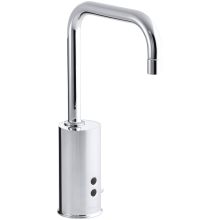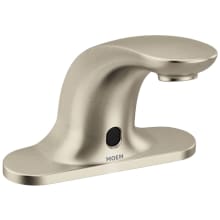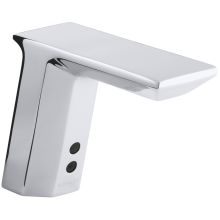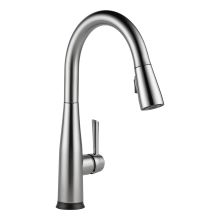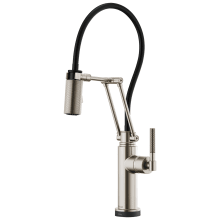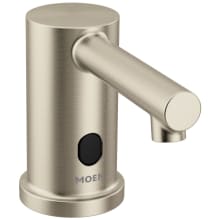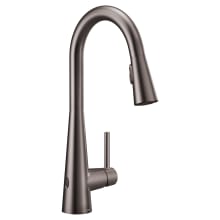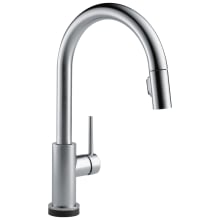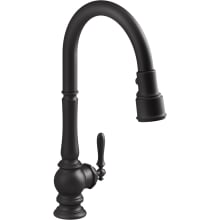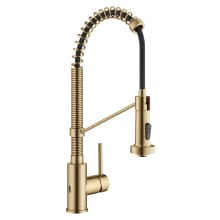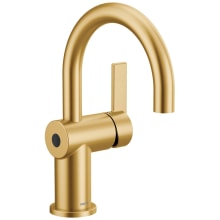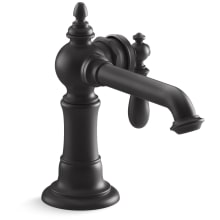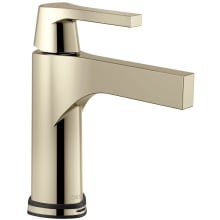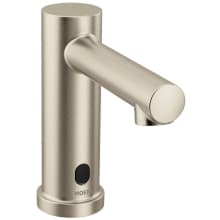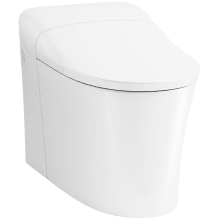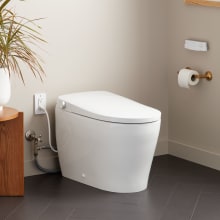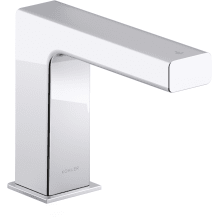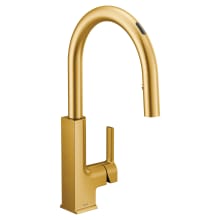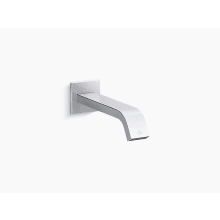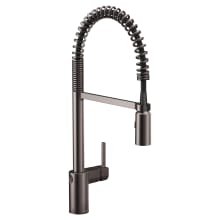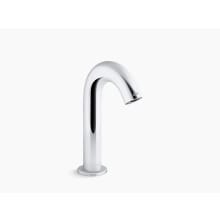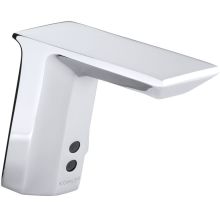The Best Touchless Faucets for Your Home
Make your home as germ-free as possible with modern touchless faucets for a hands-free kitchen or bathroom.
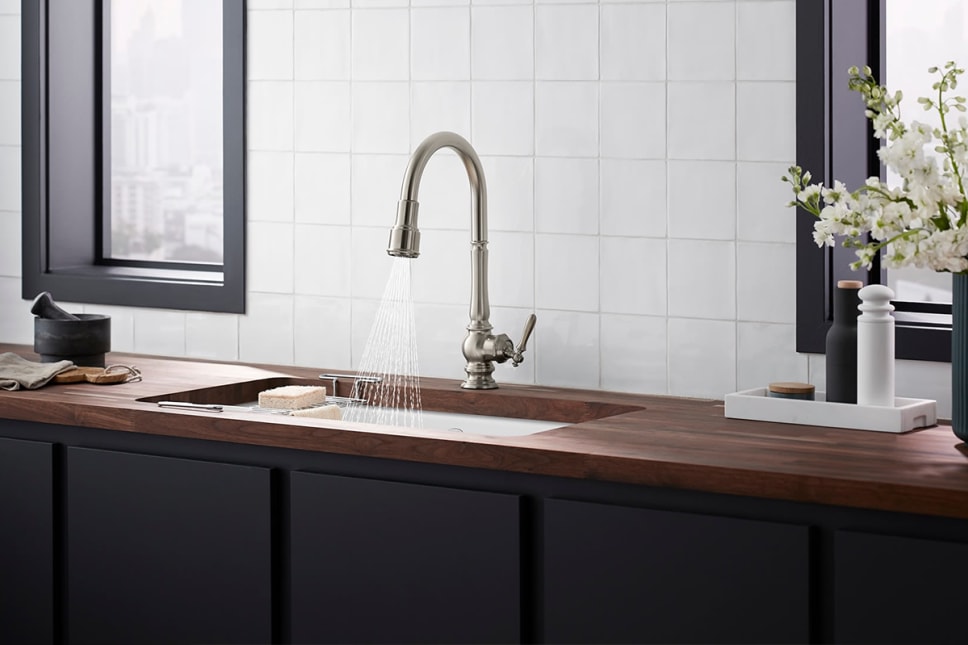
Everything is hands-free in today’s world of convenient technology, making your home easier to use and easier to maintain. From your car to your kitchen, touchless tech can help keep your family safer while saving you time on details like clean up.
Check out these home-based, hands-free solutions to spruce up your kitchen and bathroom. All of them can be found in the finish colors and endless design options to match your home, and they make great weekend projects if you choose to install them yourself as part of a quick room update.
Before You Buy
As you consider the upgrade to a touch vs touchless faucet, it’s important to look at the features that will make up the best touchless faucet for your household. While style is important, it is only one of many considerations. It’s always good to have an idea of how much use the faucet will have daily, and to make sure the materials can keep up with the demands placed on the faucet.
Materials
The materials a faucet is constructed from influence their durability and the overall quality and required maintenance over time. Stainless steel and brass are common, sturdy materials for faucets, and can be found in a variety of finish styles. You can select the color and shine that you prefer, from reflective silver, to a buffed copper, or a solid, flat black finish, all designed to find a match with the interior design of your home.

Sensor technology
The different types of touchless or touch faucets utilize sensors to trigger water flow. The sensors can be installed in multiple places on a touch or touchless faucet and are programmed to respond to either movement or direct touch, which can have some variance in sensor range between products.
Whenever possible, it’s a good idea to confirm the accuracy of the sensors and ensure that the faucet sensor will respond to the interactions that best suit your household. For instance, if you expect a faucet to respond at a wave of the hand, be sure to choose a touchless faucet with appropriately placed sensors. Look for a faucet with the sensor range and sensitivity to activate on the user’s command, rather than respond to a change in light in the room or the family cat playing with the faucet.

Power Supply
As with all modern technology, the best touchless faucets require a power supply. This low-voltage current can be established through an installed battery, or directly into the home’s power supply. Before purchasing an electronic touch or touchless faucet, have an idea of where the faucet will be placed in relation to the nearest electrical outlet and select the best power source for the location. Some units provide batteries with up to two or more years of battery life.

Flow Rate
The GPM, or gallons per minute, is an indication of how much water and pressure the unit is designed to provide. Most faucets today keep the flow rate below 2 GPM to conserve water and save your household money on the water bill. Touchless faucets and toilets are considered much more water efficient than their traditional counterparts, and many models across different brands meet the EPA’s WaterSense requirements to show they perform better than other products.
Features of the Faucet
Obviously not all sensor faucets are created to be identical. The options you choose customize your in-home, hands-free experience, so find the features that best suit your household. These features include the physical shape and operation of the faucet.
Touch faucets and touchless faucets are available in everything from a traditional design to the most popular modern body styles and finishes for the bathroom or kitchen. The location change between the kitchen and the bathroom sometimes requires a switch in design styles because the faucet features will have to change to accommodate the different needs between spaces.
The best touchless faucet is the one that does what you expect it to, whether that means low spouts and angled sensors to pick up small hands near the bathroom sink, or maybe it has a high gooseneck arch or a pull down spout to make scrubbing pots and pans easier in the kitchen. When considering pull-down or pull-out sprays, make sure to find a setup with a long enough hose for the spray faucets to move easily around the sink basin.
Some faucets offer pre-programmed water temperature settings, while others are designed with the manual handle to allow the user to customize their chosen temperature out of the tap. These systems often use lit displays to indicate the different control modes the user can choose from.
When shopping for touch vs touchless faucets, look for operational features such as an automatic shut-off timer. These types of features help you save water by ensuring that once the faucet is activated, it won’t remain on without regular movement or touch within the sensor range. Most timers limit the unattended water flow to no more than four minutes at a time. Even the most curious of cats won’t be likely to cause a sink overflow with the timer equipped.

How Do Touchless Faucets Work
All home faucets rely on mechanical valves within the faucet body to control the flow of the water from the plumbing. A touch or touchless faucet is no exception, the only difference in how they work being the amount of effort required by the user.
Solenoid Valves
The type of valve used to operate handle-free home faucets is called a solenoid valve. These solenoid valves are electro-mechanical valves that utilize magnetic power to move the valve into either an on/open or off/closed position via electric input from the infrared or touch sensors on the faucet body. Once activated, the mechanical valve moves away from the water inlet to allow water to flow to the faucet.
Movement Sensors
Movement sensors for touchless faucets work with the help of the solenoid valves. With infrared sensors, such as used by touchless faucets, there is a sensor panel embedded on the faucet near where a user’s hands would usually be held under the faucet water. The sensor’s range of sensitivity can vary by model, but it is usually effective within a few inches of the reader. The sensor turns the water on or off when it reads movement, so it is important to make sure the panel is kept clean and free of obstructions.
Capacitive Touch Sensors
Touch faucets use the same valve system to control the water flow, but the sensor trigger is different. The body of the faucet is made with a conductive metal material, such as brass. Inside the faucet is a capacitive touch sensor, which responds to the electrical energy in the human body by then triggering the valve to open or close.
Capacitive touch sensors respond to the same natural energy as the static electricity generated by walking across a carpeted floor in a low-humidity room. The low amount of the static energy is used to register the touch on the sensors, so there is no risk of any energy transfer or shock from the faucet to the user.
These sensors are capable of reacting to a brief touch anywhere on the faucet’s sensor area, or a longer touch such as to hold the spray-head of a pull-down faucet. Touch faucets may have specific settings that influence the difference in water-flow between a short touch and a longer hold, such as the water staying on for a few seconds at a brief touch or a minute or more when held continuously.
Touch & Touchless Kitchen Faucets
The kitchen is one of the busiest, messiest rooms in the home. From pots and pans to be cleaned, to multitasking when preparing meals, there’s food grime and germs over utensils and on the hands of the chef and their helpers. With a traditional kitchen faucet, the faucet handle collects everything from the dirty dishwater to food residue as it is used throughout the day.
Touch/touchless kitchen faucets reduce the mess left behind on the surfaces you touch every day in your kitchen. A wave of the hand or the light touch of the wrist against the side of the faucet produces a full stream of water, whether for filling a drinking glass or rinsing a dirty pan. The best touchless kitchen faucet reduces your family’s exposure to germs and keeps the household healthier, with less time spent cleaning.

Touch Faucets for the Kitchen
A touch-activated kitchen faucet can be turned on with the light touch of the back of the hand or arm against the sensor. These sensors are usually placed at the base of the faucet to include the handle and near the spout, especially for pulldown or pull out faucets.
A slight touch anywhere on the faucet between the receptors is enough to activate the water flow, so a user can wash up without touching the faucet with dirty hands. The user can then handle the faucet more directly with clean hands for washing dishes or other chores and keeps the kitchen cleaner.

Touchless Kitchen Faucets
With touchless kitchen faucets, the sensors pick up the motion at or near the faucet before turning on the water flow, reducing messy fingerprints and grime collecting on the finish. The best touchless kitchen faucets are available with all the most in-demand features, such as detachable spray heads with variable water pressure settings to help with cleaning tasks in the sink. Combine the motion sensor of a touchless faucet with a high-arched faucet body and a long spray hose to maximize the style and efficiency of the kitchen faucet.
Touch & Touchless Bathroom Faucets
To keep a healthy household, the CDC recommends everyone wash their hands thoroughly for at least 20 seconds. That can waste a lot of water with a traditional, handled faucet, as the water runs from the faucet without being used while the hands are lathered up.
To save on the water bill, and to save time wiping germs and soap scum off the faucet and sink edge, update to a hands-free bathroom faucet. With touch/touchless bathroom faucets, the water will only run when it is being used for hand washing or other bathroom tasks. No more leaving the faucet to run while brushing teeth. Use what is needed and not much more with a touch or touchless faucet.
To choose the best touchless faucet for your space, choose the finish color and design style to match the other fixtures and hardware in your bathroom. If it’s time for a quick bathroom remodel, find vanity hardware to match the faucet style and refresh the look of the entire bathroom.

Touch Faucets for the Bathroom
A touch faucet can be activated with the back of the wrist or arm rather than grabbing or turning a handle. A light touch on the metal near the spout can trigger the water flow to make it easy to wash up. This prevents having to touch shared surface areas on a faucet handle that might expose you to dangerous germs and viruses.

Touchless Bathroom Faucets
The best touchless faucet responds to hand movements within the sensor range, making it easier to use when your hands are occupied by bathroom chores such as toothbrushes or soapy cleaning gloves. Touchless bathroom faucets move the sensor range closer to the edge of the sink, directly under the water spout, which makes them convenient to reach and operate for anyone in the household.

Touchless Flush Toilets
Not all touchless technology is reserved for the faucet. The best electronic faucet on the market can’t save you from everything when it comes to the hazards of bathroom surfaces. One of the worst culprits for germs in the bathroom is the toilet.
Whether the toilet seat and lid or the flush handle, the surface of the toilet collects everything you don’t want your household touching between cleanings. A touchless flush toilet solves the problem of transferring surface germs by removing the manual flush.
Types of Touchless Flush toilets
When it comes to finding a touchless flush toilet, there are many types and designs to choose from but the hands-free operation remains consistent. Simply wave a hand over the tank-mounted sensor to trigger the flush, or choose models that automatically flush.
Most touchless flush models rely on infrared sensors. Some sensors will be installed at the front of the tank to detect movement over the tank and activate the flush once the user has left. Others have the sensors installed on the top of the water tank, so it will not activate until the user waves a hand over the sensor point.
There are also low-flush toilets that offer a button to push rather than a handle to grab, providing a smaller, easier to clean flush option without the sensors.

Bidets
The popular bidet toilet is a different kind of hands-free, touchless option for the bathroom as well. A bidet is a specially designed toilet or toilet accessory that uses a clean supply of water to help the user clean up their posterior after using the toilet. The addition of a bidet feature to the bathroom toilet allows basic self-hygiene practices to go completely hands-free, reducing the demand for toilet paper in the home.
It is commonly used around the world and the practice of home-use installation is gaining popularity in the US as the technology improves to make the mechanical functions more hygienic. Modern bidets are designed to wash all exposed bidet parts with sterilizing agents between uses, making them easy and healthier to maintain.
Another hands-free bonus to the bidet is that, with many bidet toilets the settings for the bidet are mounted on the wall near the toilet. Utilizing the bidet features does not require touching the toilet, and it cuts back on the need for buying extra toilet paper, too.
Commercial Touchless Options
Part of the responsibility of owning a business is to keep in mind the safety of your employees and customers in the planning of daily operations, as well as maintaining a healthy bottom line. Updating the fixtures at the office, store, or even a warehouse, to touch or touchless alternatives is a good way to do that.
Whether replacing a break room faucet or a public-facing bathroom faucet, the touchless options limit the water use to what is necessary, cutting down on the possibility of damage from a clueless customer forgetting to turn the water off, or intentional vandalism. It also limits staff and customers alike to exposure from harmful germs and viruses while they’re at your workplace.
Touchless Commercial Faucets
There is no shortage in styles when it comes to browsing commercial touchless faucets. The best touchless faucets are functional and durable while still blending in with the design of any room in the building, especially when it comes to commercial installations.
Touchless bathroom faucets offer a modern design and allow you to set a consistent water temperature so there’s no need for extra handles or touchable surfaces. Pair with a touchless soap dispenser and a wall dryer and the bathroom becomes paperless, without the need for paper towels. This simple switch even cuts back on the amount of time spent on cleaning and maintenance in the bathroom with less paper mess left behind.
Adding a touchless kitchen faucet in the break room allows a high-arch, gooseneck faucet for easily accommodating clean-up chores, like washing out the coffee pots. Also look for touchless faucets with pulldown spray heads to help direct the water spray. This is especially useful for anyone in food service.

Touchless Commercial Toilets
Many commercial toilet designs are plumbed directly into the wall and don’t rely on water storage tanks, so the look of the commercial touchless toilet often is different from a residential touchless toilet.
These toilets consist of either a floor-mounted or wall-mounted toilet base and bowl, and often only a flushometer that mounts to the wall above. The sensor technology is housed in the flushometer, rather than a water tank, and motion sensors activate the flush when movement is detected in front of the toilet bowl. The change in design takes up less visual space on the bathroom wall and is very water efficient, all without changing the actual operation of the touchless flush toilet.
Touchless Tech At Home Or The Office

Airports and restaurants have been utilizing touchless faucets and other technology for years. Now, minimizing the amount of exposure to germs and other biohazards is as easy as swapping out the bathroom or kitchen faucet at home.
Electronic faucets and other touch-free technology reduce the spread of common illnesses and will keep your family and guests healthier. Whether for the bathroom or the kitchen, the benefits of switching to touchless or touch faucets make the upgrades worth considering.

